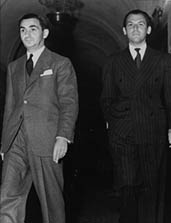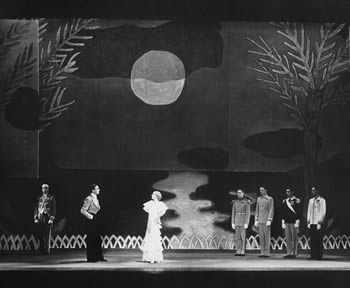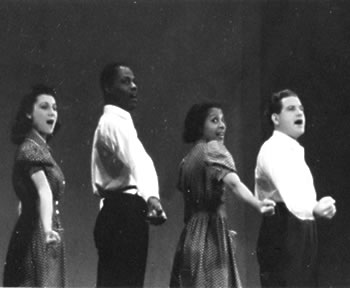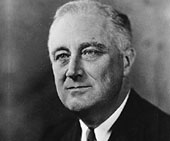Essay
Political Satire

Irving Berlin with Moss Hart
Irving Berlin’s patriotic belief in his adopted country would seem to be an affectionate constant in his career, but as the crisis of the depression deepened, even Berlin could see the box office appeal in some good old-fashioned social satire. In 1932, he teamed up with the bright young playwright Moss Hart, who had become a rising star on Broadway when he co-authored the Hollywood satire “Once in a Lifetime” with George S. Kaufman two years earlier. Kaufman’s own satirical musical, “Of Thee I Sing,” was playing to big business at the Music Box Theater, which Berlin owned, and the composer thought there might be room for another sharp show in town.
As concocted by Hart and Berlin, the plot of “Face the Music” is really a triptych of three slight social satires on the depression, the Seabury investigations — started in 1930 by then New York governor FDR to examine corruption in the mayoral administration of James J. Walker, who was eventually forced to resign — and the “Ziegfeld Follies,” tentatively stitched together. “Face the Music” opens at the Automat, where the recently humbled rich are being forced to share their modest repasts among the hoi polloi. This gave birth to the show’s biggest hit, “Let’s Have Another Cup of Coffee,” which became one of the gentler anthems of the depression.
The show’s lack of conceptual clarity is obvious from its subtitle, “A Musical Comedy Revue,” and it was not the smash return to Broadway that Berlin had anticipated. In the end, Berlin was more comfortable with the revue format — short, sharp, and quick — as he himself would be the first to admit.

Marilyn Miller, Clifton Webb, and Ethel Waters were some of the stars featured in "As Thousands Cheer."
The next season, Hart and Berlin tried again for a topical revue, and this time they kept their target well within sight and hit the bull’s-eye. “As Thousands Cheer” was typical of the general trend in the 1930s of giving the revue form some kind of structural or thematic unity. In this, the team achieved a kind of brilliance; “As Thousands Cheer” took as its “concept” the form of a daily newspaper, with each number and skit taken from (or performed in ironic contrast to) a particular headline or column — which was projected across the proscenium. (This was several years before the Federal Theatre Project created a unit called “The Living Newspaper” that dramatized political stories in documentary form.) This allowed Hart to parody such wet-ink-fresh subjects as the building of Rockefeller Center (“World’s Wealthiest Man Celebrates 94th Birthday”) and the outgoing Hoover administration, where the ex-president and his wife run up a huge last-minute long-distance phone bill (“Franklin D. Roosevelt Inaugurated Tomorrow”). Berlin took a gentler swipe at society — with the extraordinary exception of “Supper Time” for Ethel Waters — by kidding Josephine Baker (“Harlem on My Mind”), Woolworth heiress Barbara Hutton (“How’s Chances?”), and even the hoary conventions of the revue format itself (“Supreme Court Hands Down Important Decision”) that forbid revues from reprising their most memorable songs in the finale.

The creators of "Of Thee I Sing"
A month after “As Thousands Cheer” opened on Broadway, in September 1933, Kaufman, Morrie Ryskind, and the Gershwins returned with “Let ‘Em Eat Cake,” a rare musical sequel to “Of Thee I Sing,” with the same cast of characters. The score was even more sophisticated than the original show’s, but the book’s often depressing take on fascism — President Wintergreen overthrows the government after losing reelection — ground audiences down rather than inspiring them. And it’s likely the show was simply a formalistic copy of the original. It was a costly failure, opening and closing after 90 performances at the Imperial Theater, while Berlin was clocking 400 performances of “As Thousands Cheer” at his very own Music Box Theater.
But all this was probably more a matter of craft than sentiment; as the 1930s wore on, political satire on Broadway became more, rather than less, popular. Times were getting more complex, and the Broadway musical was never more topical than it became in the latter part of the decade. In late 1937, four intensely political musicals opened on Broadway: “The Cradle Will Rock,” “Pins and Needles,” “I’d Rather Be Right,” and an antiwar satire starring Ed Wynn called “Hooray for What.” The style of the shows ranged from the sublime to the ridiculous — but they each caught a different facet of the American consciousness. By the fall of 1937, it looked as if the depression would be forever clouding the skies. A whopping budget deficit, a series of explosive struggles between management and labor, the progressive unionization of America — these events filled the headlines and made their appearance, one way or another, on the Broadway musical stage.
David Dubinsky was the powerful head of the International Ladies’ Garment Workers’ Union in the 1930s. He was devoted to the betterment of his union members, who had trebled in number since the New Deal was instituted. One of Dubinsky’s ideas was a Cultural Division, which made “good union members aware of the truth that man does not live by bread alone.” In the mid-1930s, the division took the unconventional step of hiring songwriter Harold Rome to write a musical revue for the ILGWU, called “Pins and Needles.” Actors and singers were recruited from among union members, and they rehearsed after work three hours a night, three nights a week; it took a year to rehearse the show. “Pins and Needles” was a lighthearted look at young workers in a changing society in the middle of America’s most politically engaged city. The opening number let the audience know where the hearts of these young people lay:
Sing me of wars and sing me of breadlines, Tell me of front-page news. Sing me of strikes and last minute headlines. Dress your observation in syncopation. Sing me a song with social significance. There’s nothing else that will do. It must get hot with what is what, Or I won’t love you.

Singers in the pro-union musical "Pins and Needles."
The show had an extraordinarily long run for the period — 1,108 performances — but that was largely because its theater, the Labor Stage, had only 300 seats. The success of the show even surprised Harold Rome: “I didn’t realize that the big attraction was that the garment workers themselves were doing the show and singing to the audience, creating a rapport which is very rare in the theater.”
Opening three weeks before “Pins and Needles,” “I’d Rather Be Right” went straight to the top for its satirical target: President Roosevelt himself. In our current era, saturated with SATURDAY NIGHT LIVE parodies and talk-show monologues, it’s hard to see how revolutionary it was for Kaufman and Hart and Rodgers and Hart to put a sitting president on stage for two-and-a-half hours of comic ribbing. To be fair, all four creators were good New York liberals, so the arrows sent FDR’s way were not exactly tipped with venom, but the president was summarily chided for his attempt to pack the Supreme Court (all nine pop out of the bushes to shout down FDR every time he proposes a new law), his failure to balance the budget, his ambition for a third term, even his frequent browbeating at the hands of his overbearing mother. The high profiles of the creative staff, plus the electric performance of George M. Cohan, made the show the hit of the season, even with — or perhaps because of — its sentimental closing speech, which had FDR rallying America with a fireside chat.

President Roosevelt was the subject of "I'd Rather Be Right"
A year later, Kaufman and Hart teamed up to produce (and rewrite) “Sing out the News,” the first commercial Broadway revue for Harold Rome. It had a strong, but less pungent, liberal agenda than “Pins and Needles”; if that show played like a musical version of THE NATION magazine, “Sing out the News” played more like the TIMES Op-Ed page. Sketches included the difficulties within the Republican Party in finding a candidate to run against FDR (an angel who loses his wings accepts the job) and a song set at a Harlem block party where a new black baby is christened “Franklin D. Roosevelt Jones,” which, according to the joyous celebrants, augurs well for his future.
The freewheeling satire of the 1930s would soon be curtailed by the overwhelming patriotism accompanying the onset of World War II. Even as war became imminent in Europe, it was clear that the Broadway stage’s freedom to poke fun at whomever it chose was a gift that theatergoers — and Americans — could no longer take for granted. Critic John Mason Brown articulated this in his review of “I’d Rather Be Right”:
It should swell our pride in the freedom we enjoy and the gift for laughter which must be counted among our national assets. The more good humored liberties Mr. Kaufman and Mr. Hart’s satire takes, the more liberty its mere performance bespeaks.
Photo credits: Photofest and National Archives and Records Administration

